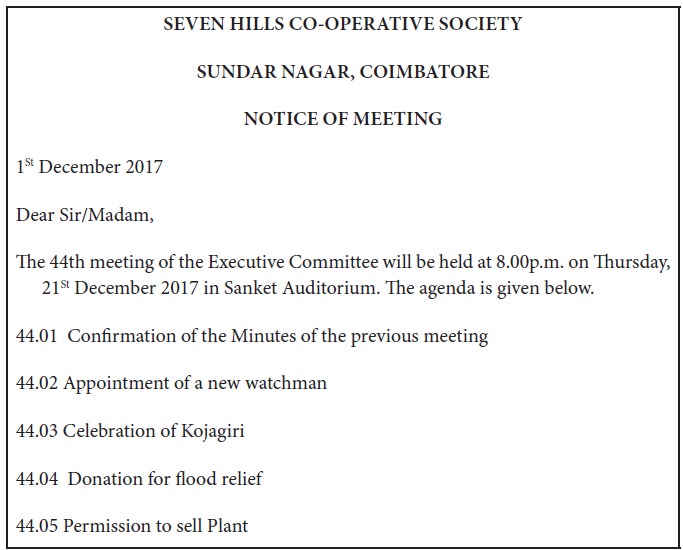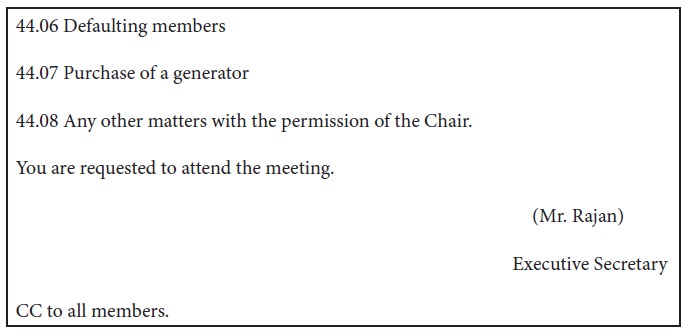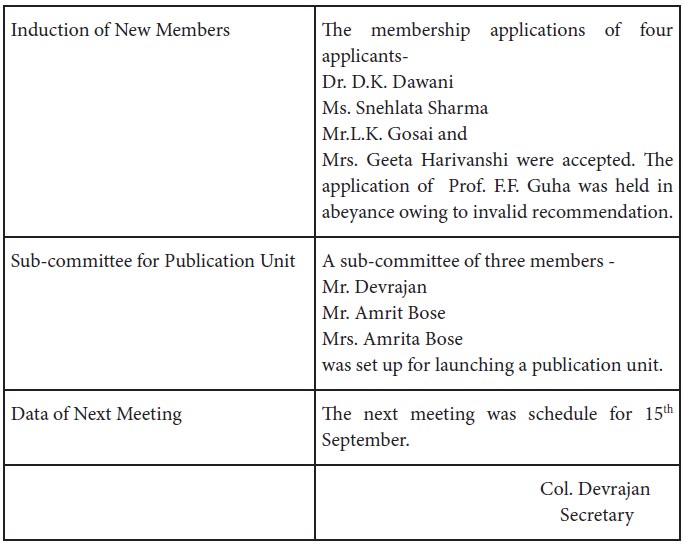Office - Documents to be Prepared Before and After Meetings | 11th Office Management and Secretaryship : Chapter 10 : Meeting and Report Writing
Chapter: 11th Office Management and Secretaryship : Chapter 10 : Meeting and Report Writing
Documents to be Prepared Before and After Meetings
Documents
to be Prepared Before and After Meetings:
An
official meeting is supported by several written documents. For the smooth
functioning of a meeting, supporting documents must be prepared carefully.
Usually, they are prepared by the Secretary, in consultation with the chairman.
In small business units these documents are prepared by office manager himself.
The
most essential documents needed to be prepared in connection with meeting are
Notice, Agenda and Minutes. Of these, Notice and Agenda are prepared before the
meeting and Minutes is prepared after the completion of meeting.

Before the Meetings
Notice Calling the Meeting:
When
a meeting is to be conducted, a notice is required to be sent to all the
members. A Notice is an intimation about the conduction of the meeting.
Generally, it is typed or printed on the organizations’ letterhead and issued
under proper authority. Notice of the meeting must include the following
content.
·
The
name of the organisation.
·
Day,
date, and time.
·
Place
of the meeting. i.e. the address and the specific room/hall
·
Purpose
of the meeting and, if possible, the Agenda.
·
Date
of circulation and conveners’/ secretary’s signature
Public
companies and many registered voluntary organisations use a legal form of
notice for general body meetings. The notice is accompanied by the agenda for
the present meeting and the minutes of the previous meeting. The notice of the
meeting must be sent well in advance. Usually, at least seven days’ notice
should be given to all the members attending the meeting. If members are
located at far away distances, a longer notice (i.e., at least 21 days’ notice)
should be given.
Example: 1. Notice Calling Board
Meeting:

Example: 2 Agenda of Board Meeting:

Agenda:
Agenda
means things to be done. It is also called as business or order of business to
be discussed during the meeting. According to Rajendra Pal and Korlahalli,
“Agenda is document that outlines the contents of a forth coming meet”.
It
is programme schedule of the meeting and prepared by convenor or secretary in
consultation with chairperson and his approval and sent along with the notice
of the meeting in order to enable the members to come prepare for discussion
during the meeting. An agenda begins with the call to order meeting and ends
with postponement of the meeting. It should cover the following.
·
Reading
and approval of minutes of the last meet
·
Matters
arising out of previous meet’s minutes
·
Apologies
from absent members.
·
Condolences
if any
·
Urgent
and non-controversial items
·
Matters
requiring closer discussion and debates
·
Any
new, on-the-spot items with the approval of the chairman
·
Date
of next meeting
·
Vote
of thanks to the chairman.
Example : 1. Agenda of Annual
General Meeting:


Example: 2 Agenda of Board Meeting:


Importance or necessities of Agenda:
The
necessities or importances of agenda are follows:
·
As
it is circulated in advance, it helps the member to come prepared for the
meeting.
·
Since
agenda has a set order, it help the chairperson to conduct the meeting
smoothly.
·
It
ensures that only matters relevant to that particular meeting are discussed.
·
It
makes sure that every point is properly taken up for discussion.
·
Agenda
facilitates the preparation of the minutes
After the Meeting:
Minutes:
Minutes
is a record of the decisions taken at a formal meeting. All companies,
statutory bodies, social organisations, associations and committees have to
maintain a record of the meetings. As minutes are the official record of work
done and decision taken at the meeting, it must be precise and clear. Once
minutes are approved and signed, it can be even accepted by the court of law as
evidence of the proceedings of meeting.
The
main objective of minutes is to record, concisely and accurately, the essential
work done at a meeting. The minutes of companies and statutory bodies are
written in formal style.
Other
organisations may write minutes in informal style. It should contain the
following details.
·
The
name of the organisation.
·
Day,
date, time and place
·
Number
in order (e.g. 33rd meeting of …….)
·
Names
of chairperson and secretary
·
Names
of members present
·
Names
of the members absent.
·
Attendees
by special invitation, e.g. auditor, caterer, banker, etc.,
·
Record
of the transactions.
·
Signature
of the secretary after approval of minutes by the chairman.


Meaning of E-form:
e-
form is a electronic paper document generated from the computer. many companys
are in the problem of reviewing their office documentation and ways of
converting their use of data, forms and other paper based processes to
electronic or digital online processes.
Some
of e- forms used in connection with meetings or stated below:

Related Topics